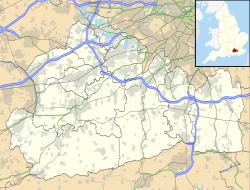| All Saints' Church, Grayswood | |
|---|---|
 | |
| 51°06′18″N0°41′29″W / 51.1049°N 0.6915°W | |
| Denomination | Church of England |
| Website | All Saints |
| History | |
| Dedication | All Saints |
| Architecture | |
| Functional status | Church of England parish church |
| Heritage designation | Grade II |
| Designated | 19 September 1977 |
| Architect | Axel Haig |
| Style | Arts and Crafts |
| Administration | |
| Province | Canterbury |
| Diocese | Guildford |
| Archdeaconry | Surrey |
| Deanery | Guildford |
| Parish | United Benefice of Haslemere and Grayswood |
| Clergy | |
| Vicar | Rev Fiona Gwynn |
All Saints' Church is an active parish church in the village of Grayswood, Surrey, England. The church stands in the centre of the village and was built between 1900 and 1902. Designed by the Swedish artist Axel Haig, who lived in the village and is buried in the graveyard, the church is a Grade II listed building.





